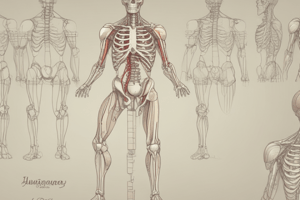Podcast
Questions and Answers
What is the term for the movement that decreases the angle between two bones?
What is the term for the movement that decreases the angle between two bones?
- Flexion (correct)
- Extension
- Adduction
- Abduction
What is the process of measuring joint ROM using a specialized instrument?
What is the process of measuring joint ROM using a specialized instrument?
- Circumduction
- Goniometry (correct)
- Abduction
- AROM
Which type of movement is characterized by rotating around a central axis?
Which type of movement is characterized by rotating around a central axis?
- Circumduction
- Flexion
- Rotation (correct)
- Extension
What is the range of motion achieved by an individual's own muscle power?
What is the range of motion achieved by an individual's own muscle power?
What is the main benefit of maintaining or improving ROM in terms of injury prevention?
What is the main benefit of maintaining or improving ROM in terms of injury prevention?
What is the term for the movement that involves moving a body part in a circular motion?
What is the term for the movement that involves moving a body part in a circular motion?
ROM is typically measured in units of meters.
ROM is typically measured in units of meters.
Women generally have a lower ROM than men in the hips and knees.
Women generally have a lower ROM than men in the hips and knees.
Electromyography (EMG) is a technique used to measure joint angles and ROM.
Electromyography (EMG) is a technique used to measure joint angles and ROM.
Maintaining optimal ROM can reduce the risk of injury during physical activity.
Maintaining optimal ROM can reduce the risk of injury during physical activity.
ROM exercises are used to diagnose joint injuries.
ROM exercises are used to diagnose joint injuries.
ROM is an important factor in maintaining joint health and flexibility.
ROM is an important factor in maintaining joint health and flexibility.
Flashcards are hidden until you start studying
Study Notes
Range of Motion
Definition
- The range of motion (ROM) refers to the extent of movement possible in a specific joint or series of joints.
Types of Movement
- Flexion: Movement that decreases the angle between two bones (e.g., bending elbow).
- Extension: Movement that increases the angle between two bones (e.g., straightening elbow).
- Abduction: Movement away from the midline of the body (e.g., raising arm out to the side).
- Adduction: Movement towards the midline of the body (e.g., bringing arm back to the body).
- Rotation: Movement around a central axis (e.g., rotating head from side to side).
- Circumduction: Circular movement (e.g., moving arm in a circle).
Measurement
- Goniometry: The process of measuring joint ROM using a goniometer.
- Active range of motion (AROM): The range of motion achieved by an individual's own muscle power.
- Passive range of motion (PROM): The range of motion achieved with external assistance.
Importance
- Injury prevention: Maintaining or improving ROM can help prevent injuries.
- Rehabilitation: ROM exercises are essential in physical therapy to restore function and mobility after injury or surgery.
- Performance enhancement: Increasing ROM can improve athletic performance and reduce risk of injury.
Studying That Suits You
Use AI to generate personalized quizzes and flashcards to suit your learning preferences.




